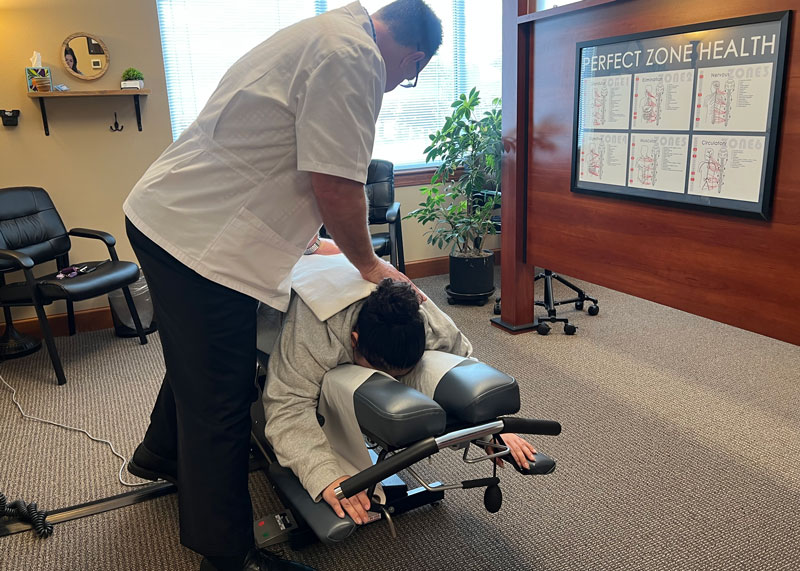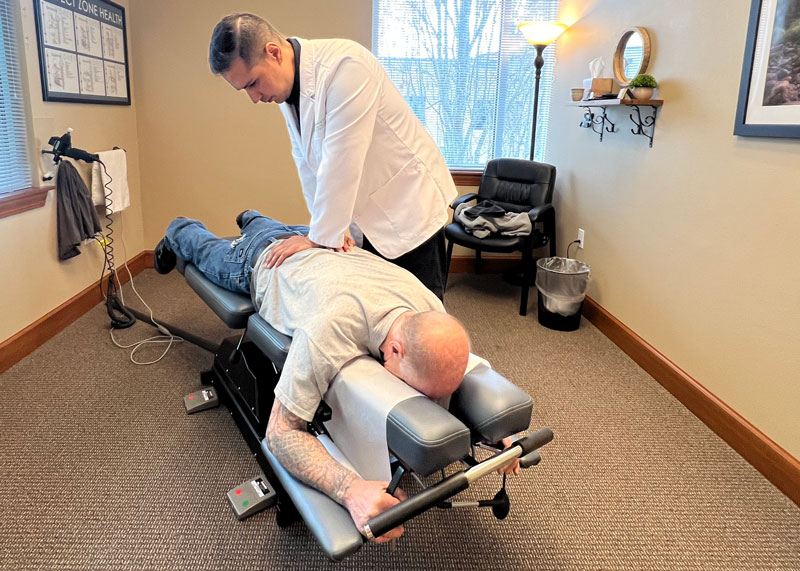You may find yourself seeking help for various issues, and chiropractors play an necessary role in caring for your spine and overall wellbeing. These trained professionals focus on diagnosing and treating musculoskeletal disorders, particularly those affecting your spine. Through careful assessments, including your medical history and physical examinations, they create tailored adjustment plans to improve your movement and relieve pain. Whether struggling with chronic back pain or discomfort in any part of your body, a chiropractor can help guide you towards better health. So let’s see what does a chiropractor do.
Key Takeaways:
- A chiropractor focuses on improving spinal alignment through manual adjustments, which can help alleviate pain and enhance mobility.
- Common benefits of chiropractic care include relief from lower back pain, neck pain, and headaches, though research on its effectiveness for other conditions is limited.
- Chiropractic adjustments are generally safe when performed by a licensed professional, with mild side effects that usually resolve within a day.

Understanding Chiropractic Care
While many people think of chiropractors primarily as pain relief specialists, the scope of chiropractic care extends much further. Chiropractors are trained to focus on the relationship between your spine and nervous system, which can have widespread implications for your overall health. By improving alignment and movement within the spine, chiropractors aim to enhance your body’s ability to heal itself and maintain wellness. This holistic approach is becoming increasingly popular as people seek alternatives to medication and invasive procedures for managing pain and enhancing their quality of life.
History of Chiropractic Medicine
Behind the emergence of chiropractic care is a rich history that dates back to the late 19th century. The profession was founded in 1895 by Daniel David Palmer, who performed the first chiropractic adjustment on a patient, believing that misalignments in the spine could cause various health problems. This foundational idea has driven the evolution of chiropractic practices, as they gained recognition as a legitimate form of health care dedicated to restoring optimal function and health through spinal manipulation.
Over the decades, chiropractic care evolved, moving from its early, somewhat controversial roots into a widely respected field today. With the establishment of chiropractic colleges and the expansion of research into its efficacy, chiropractic has become a focal point for those looking for an alternative to traditional medical approaches for conditions such as low back pain and neck pain.
Philosophy and Principles of Chiropractic
To understand chiropractic care, it’s vital to recognize its foundational principles. At its core, chiropractic is based on the belief that the body has an inherent ability to heal itself when the spine is properly aligned. This philosophy emphasizes the interconnectedness of the spine, nervous system, and overall health, suggesting that misalignments can lead to a range of health issues.
Chiropractic principles advocate for a comprehensive approach to health, where preventive care and maintenance are just as important as treatment. By aligning your spine, you may experience benefits beyond pain relief, such as improved function and overall well-being.
Role of the Chiropractor
After considering the philosophy behind chiropractic care, you might wonder what the actual role of a chiropractor involves. Chiropractors assess your condition through thorough examinations, including healthcare histories and physical assessments, to determine the most effective treatment approach tailored to your individual needs. They apply adjustments to realign your spine, which may improve mobility, alleviate pain, and promote a healthier nervous system.
With a focus on holistic healing, chiropractors not only perform adjustments but also educate you about lifestyle choices that promote better spinal health. This can include advice on posture, exercise, and nutritional considerations, aiming to empower you with knowledge and tools to maintain your well-being actively.

The Spine and Its Importance
One key aspect of your overall health is the condition of your spine. The spine is a complex structure made up of a series of vertebrae that protect your spinal cord, provide structure to your body, and enable movement. Maintaining spine health is vital not only for pain relief but also for the proper functioning of your nervous system. When your spine is in alignment, signals can travel more efficiently between your brain and the rest of your body, influencing everything from muscle coordination to organ function.
Anatomy of the Spine
The spine consists of 33 vertebrae divided into five regions: cervical, thoracic, lumbar, sacral, and coccygeal. The cervical region includes the first seven vertebrae in your neck, followed by twelve thoracic vertebrae in your upper back, and five lumbar vertebrae in your lower back. The sacrum and coccyx consist of fused vertebrae, forming the base of your spine. Each vertebra is separated by intervertebral discs that act as shock absorbers, allowing for flexibility and movement.
Function of the Spine in Overall Health
Spine plays a pivotal role in your overall health by supporting your body’s weight, allowing movement, and protecting your spinal cord. An aligned and healthy spine contributes to proper posture, which can reduce strain on muscles and joints, fostering better physical performance and overall well-being. Conversely, misalignments can lead to discomfort and a range of issues, including lower back pain and headaches.
In fact, research shows that conditions like low back pain and neck pain can often be traced back to spinal misalignment. Keeping your spine healthy through chiropractic adjustments can alleviate these issues, enhance mobility, and contribute to a higher quality of life. By ensuring that your spine is in proper alignment, you are actively supporting your body’s ability to heal and function optimally.
Common Spinal Disorders
Common spinal disorders include conditions such as herniated discs, sciatica, and spondylosis. These disorders can arise from wear and tear, injuries, or poor posture, impacting your ability to move freely and comfortably. Many individuals experience varying levels of pain and discomfort due to these conditions, which can significantly affect your daily activities. It’s important to address these issues promptly to avoid further complications.
Importance of regular check-ups with a chiropractor lies in their ability to diagnose and treat these disorders effectively. By employing techniques such as spinal manipulation, chiropractors can help relieve pain and restore mobility, allowing you to regain not just comfort, but also functionality in your everyday life. Addressing spinal health is an investment in your overall wellbeing.
Types of Chiropractic Adjustments: What Does a Chiropractor Do
For those seeking to improve their spine health and overall wellbeing, understanding the various types of chiropractic adjustments is necessary. Chiropractors employ several techniques tailored to your specific needs, aiming for optimal spinal alignment and pain relief. These techniques can include:
- Manual Adjustments
- Instrument-Assisted Adjustments
- Other Techniques and Modalities
- Flexion-Distraction Techniques
- Soft Tissue Therapy
Knowing the different adjustment methods available can help you feel more informed and engaged in your healthcare journey.
| Type of Adjustment | Description |
|---|---|
| Manual Adjustments | Hands-on manipulation of the spine to improve alignment and relieve pain. |
| Instrument-Assisted Adjustments | Use of specialized instruments to apply targeted pressure. |
| Flexion-Distraction Techniques | Gentle stretching of the spine while adjusting to decrease pain. |
| Soft Tissue Therapy | Focuses on muscle relaxation and pain relief through massage. |
| Rehabilitative Exercises | Strengthening exercises designed to support recovery and prevent injury. |
Manual Adjustments
Below, you will find that manual adjustments are perhaps the most traditional and widely used method by chiropractors. This technique involves hands-on manipulation where the chiropractor applies controlled pressure to your spinal joints. The aim is to restore spinal alignment, alleviate discomfort, and enhance mobility. You may hear a popping or cracking sound during the process, which is simply the release of gases from your joints, a normal phenomenon associated with these adjustments.
Manual adjustments can be particularly effective for conditions such as low back pain and neck pain. While relief can often be immediate, ongoing treatment may be necessary to maintain optimal spinal health and prevent recurrence of discomfort.
Instrument-Assisted Adjustments
Before your chiropractor employs instrument-assisted adjustments, they will evaluate your specific condition to determine the most appropriate technique for you. This method uses specialized instruments to deliver precise adjustments to the spine and other joints, often allowing for a gentler treatment than manual adjustments. The instruments can control the force and speed of the adjustments, leading to enhanced comfort during the procedure.
Typically, you will find instrument-assisted adjustments useful if you prefer a less forceful approach or if your chiropractor recommends a more targeted technique. This can also be beneficial for individuals with conditions that weaken the spine, as it reduces the risk of injury while still providing effective relief.
To experience the benefits of instrument-assisted adjustments, you may discover that they provide comfort, precision, and continuous motion which are particularly advantageous for patients with heightened sensitivity or discomfort.
Other Techniques and Modalities
About enhancing your treatment, chiropractors often incorporate other techniques and modalities in conjunction with spinal adjustments. These may include therapeutic exercises, physical therapy modalities, and lifestyle counseling. The goal of implementing these additional techniques is to address and support your overall health rather than solely focusing on spinal alignment.
Even in a comprehensive care approach, your chiropractor may suggest incorporating soft tissue therapies such as massage or myofascial release to relieve muscle tension, combined with strength-training exercises to fortify your back. This multimodal strategy contributes not only to immediate pain relief but also to long-term wellbeing and spinal health.

The Chiropractic Consultation Process
Despite the growing popularity of chiropractic care, many individuals still hold misconceptions about the consultation process. Understanding what to expect can enhance your experience and lay the foundation for effective treatment. During your initial visit, your chiropractor will focus on gathering detailed information about your health history and specific concerns you may have regarding your spine and overall wellbeing.
Patient History and Examination
Behind every successful chiropractic treatment lies a thorough assessment of your medical history and current health status. Your chiropractor will ask you a series of questions regarding past injuries, surgeries, and any existing conditions that may impact your spine. This dialogue not only helps them understand the context of your pain but also aids in tailoring an effective treatment plan. They will conduct a physical examination with a particular focus on your spine, assessing for alignment, mobility, and tenderness.
Diagnostic Techniques
On top of the initial assessment, your chiropractor may utilize various diagnostic techniques to further investigate your condition. Imaging tests such as X-rays, CT scans, or MRIs may be recommended to provide a clearer picture of your bones and joints. These tools help identify any abnormalities or misalignments that may not be visible during the physical examination, allowing for a more precise diagnosis.
Even if imaging isn’t immediately necessary, your chiropractor might use functional assessments or motion tests to evaluate your range of motion and identify any specific problem areas. This combination of methods ensures a comprehensive understanding of your unique situation, ultimately facilitating a more effective treatment strategy.
Treatment Planning
Along with the diagnostic process, your chiropractor will devise a personalized treatment plan based on their findings. This plan may include chiropractic adjustments, stretches, and recommendations for lifestyle modifications aimed at improving your spinal health. The chiropractor’s goal is to align your spine properly, relieve pain, and enhance your overall movement, particularly if you’re experiencing lower back or neck pain, which are common reasons many individuals seek care.
Due to the individualized nature of chiropractic care, your treatment plan may evolve over time. As you progress and respond to treatment, your chiropractor may make adjustments to the plan to optimize your recovery. This dynamic approach ensures that you receive the most effective care tailored specifically to your needs and goals.
The Adjustment Procedure
Once again, a chiropractic adjustment is a treatment designed to improve your movement and relieve pain in your spine. During this process, your chiropractor uses their hands or special instruments to apply quick thrusts aimed at correcting your spinal alignment. The adjustment typically involves positioning you on a padded table, allowing the chiropractor to focus on specific areas of your spine, applying controlled pressure to achieve optimal alignment. This technique not only aims to ease discomfort but also enhances overall functionality in your daily activities.
What to Expect During an Adjustment
Adjustment procedures are generally straightforward. When you visit your chiropractor, they will begin by asking about your medical history and performing an examination that may include imaging tests. Once a treatment plan is established, you will lie face down on a padded table, where the chiropractor will focus on specific areas of your spine, applying quick thrusts to the targeted joints. You might hear a popping sound during this process, which is entirely normal and happens as gasses release from your joints. You should feel little to no pain during the adjustment, although some mild soreness might occur afterward.
Techniques Used in Adjustments
Techniques vary depending on the chiropractor’s training and your specific needs. They may employ methods like spinal manipulation, which involves applying force to a joint, or using instruments that deliver controlled pressure. Some chiropractors also use techniques such as Activator Method, Gonstead, or Diversified techniques, which focus specifically on joint alignment and mobility. It’s crucial that your chiropractor tailors their approach to fit your individual condition, ensuring that the treatment is both effective and safe.
Understanding these techniques provides insight into how chiropractic care works. Each method is tailored to address particular issues, such as low back pain or neck discomfort, facilitating effective alignment and pain relief. The chiropractor’s skill and your active participation in the process contribute significantly to the overall success of the treatment.
Aftercare and Home Exercises
Between your chiropractic adjustments, your chiropractor may recommend specific aftercare techniques and home exercises to enhance your recovery and maintain mobility. These may include applying ice or heat to sore areas and performing recommended stretches to keep your joints flexible. Following their guidance can lead to improved outcomes and help you manage your discomfort more effectively.
Procedure-wise, engaging in aftercare is vital for supporting your wellness journey. By integrating the suggested stretches and therapies into your routine, you can significantly enhance the benefits of your adjustment and foster longer-lasting relief from discomfort. This proactive approach empowers you to take control of your health and well-being.
Conditions Treated by Chiropractors
Unlike many other healthcare providers, chiropractors specialize in addressing conditions related to your spine and musculoskeletal system. They often treat issues such as lower back pain, neck pain, and various headache types. Signs of discomfort in these areas can significantly affect your daily life, leading many to seek out chiropractic care as a less invasive alternative to medications or more extensive treatments. By focusing on spinal alignment and movement, chiropractors aim to relieve pain and improve your overall well-being.
Musculoskeletal Issues
Behind every complaint of back or neck pain lies a complex interplay of muscle, joint, and nerve function. Chiropractors assess these musculoskeletal issues through a detailed examination, which may include your medical history and potential imaging tests. They use specific techniques to manipulate your spine, aiming to alleviate discomfort and improve joint mobility. Conditions like sciatica, which involves pain radiating from the lower back down to the leg, can also be treated effectively through these adjustments.
Neurological Conditions
Musculoskeletal issues often intertwine with neurological conditions, as misalignments in your spine can affect nerve function. Chiropractors are trained to recognize these connections, understanding that a properly aligned spine can positively influence nerve health. Patients may experience relief from various neurological symptoms, including tingling sensations and headaches. These conditions highlight the importance of addressing spinal alignment to support your nervous system.
A chiropractic adjustment can help improve blood flow and reduce nerve irritation, which may alleviate symptoms associated with conditions such as migraines or other headache types. While the effectiveness of chiropractic care varies per individual, many report improved quality of life after treatment.
Chronic Pain Management
Above all, chiropractic care works towards the management of chronic pain, such as persistent back pain or recurring tension headaches. This approach is about more than just immediate relief; it aims to empower you with strategies and techniques for long-term health. By incorporating adjustments, lifestyle advice, and rehabilitation exercises, chiropractors provide a comprehensive framework to address your concerns.
Plus, many patients find chiropractic adjustments to be a safer alternative to long-term medication use. Chiropractors focus on your overall health and wellness, ensuring that you receive tailored care that suits your individual needs. By understanding your body’s unique mechanisms, you can work together to create a plan that not only treats pain but promotes enduring well-being.
Benefits of Chiropractic Care
After seeking chiropractic care, you may experience a range of benefits that contribute to your overall quality of life. The primary focus of chiropractic adjustments is to enhance your spinal alignment, which can naturally lead to improvements in various aspects of your physical health and well-being. Many individuals report a significant reduction in pain levels and enhanced functionality in their daily routines.
Pain Relief and Management
Between the various issues that can result from misalignment, chiropractic care is often recommended for individuals struggling with conditions like low back pain, neck pain, and even some types of headaches. By effectively manipulating the spine, chiropractors help to alleviate discomfort, providing you with a safer alternative to medications like opioids, which can lead to dependency and other health issues. While evidence on the effectiveness of chiropractic care for conditions like sciatica exists but is limited, many patients still report positive outcomes.
Enhanced Mobility and Function
With regular chiropractic adjustments, many individuals experience improved range of motion and flexibility. As you maintain better alignment, the discomfort that might restrict your movement is significantly reduced, allowing you to engage in physical activities with more ease and confidence. Enhanced mobility also plays a role in preventing future injuries and maintaining your overall physical health.
This improvement in mobility can be attributed to the chiropractor’s targeted adjustments that help relieve tension and improve the function of your spine and joints. When your body moves freely, daily activities become less taxing; whether you’re performing household chores or participating in your favorite sports, you’ll find that you can do so with greater comfort and efficiency.
Overall Wellness and Preventative Care
Behind the immediate benefits of pain relief and improved movement, chiropractic care also plays a significant preventative role in your health journey. Regular adjustments not only target current issues but are designed to enhance your body’s overall functioning. This proactive approach can lead to better long-term outcomes for your overall wellness, helping to keep potential issues at bay.
Understanding that chiropractic care fosters not only pain relief but also systematic wellness can significantly change your health outlook. As you prioritize regular visits, you’re investing in not just recovery, but in maintaining a healthier lifestyle that aligns with your wellness goals.
Risks and Considerations
For many seeking relief from spinal discomfort and other issues, chiropractic care can be a beneficial option. However, it is important to be aware of the potential risks and considerations involved with this treatment. Generally, chiropractic adjustments are considered safe, particularly when performed by a licensed and trained chiropractor. Mild side effects such as soreness, headaches, or fatigue might occur after your session but typically resolve within a day. There have been rare reports of more serious complications, including herniated disks and nervous system problems, emphasizing the need to approach chiropractic care with informed caution.
Potential Side Effects
By undergoing chiropractic adjustments, you may experience some level of discomfort initially, though it should not be painful. Common side effects include mild soreness in the treated areas due to the physical manipulations your body undergoes. Many patients report feeling a bit of fatigue or even mild headaches following their appointment. Although most people recover quickly from these effects, it is beneficial to communicate with your chiropractor about any symptoms you experience post-adjustment for proper guidance.
When to Avoid Chiropractic Care
On the other hand, there are specific instances when it is advisable to steer clear of chiropractic adjustments. If you have severe osteoporosis, a history of cancer in your spine, or a heightened risk of stroke, chiropractic care might not be safe for you. It’s also suggested to consult your doctor if you are pregnant, as the safety of chiropractic treatments during pregnancy has not been extensively studied.
Plus, if you have recently experienced trauma, such as a car accident or a fall, it is important to seek medical evaluation before considering chiropractic adjustments. Conditions like hernioated disks, severe arthritis, or inflammatory diseases may also warrant caution with chiropractic treatments. Knowing your medical history and discussing these factors with your chiropractor will ensure you receive the safest and most effective care.
Integrating Chiropractic with Other Treatments
For optimal well-being, combining chiropractic care with other forms of treatment can enhance your journey toward recovery. Many patients find that integrating chiropractic adjustments with traditional medical care, physical therapy, or exercise regimens yields better results for managing pain and improving mobility. Discussing a comprehensive treatment plan with your healthcare providers can help tailor an approach that best suits your individual needs.
Also, involving additional therapies may help target issues from multiple angles. For instance, coupling chiropractic adjustments with massage therapy can provide greater relief from muscle tension and promote relaxation. Integrating your chiropractic care with nutritional guidance and mental wellness practices can further support your overall health and enhance the benefits of your treatment. Making informed choices about combining therapies can significantly improve your path to well-being.
Chiropractic Care for Different Populations
Not everyone is the same, and chiropractic care can be tailored to meet the needs of various populations, including children, pregnant women, and elderly patients. Each group has distinct health concerns that chiropractors can address to enhance overall well-being. For instance, when considering chiropractic adjustments, it’s vital to understand how these treatments can be adapted safely and effectively for each demographic, maintaining efficacy while prioritizing patient safety.
Children and Adolescents
With growing bodies, children and adolescents can face unique spinal challenges due to rapid growth and active lifestyles. Chiropractic care for younger individuals often includes assessments of posture, alignment, and any pain-related issues they may experience from sports or daily activities. Many parents turn to chiropractic adjustments to help with conditions such as growing pains, back pain, and headaches, potentially offering a natural way to relieve discomfort without medications.
Moreover, chiropractic care can support overall health by encouraging proper spinal alignment, which is vital for optimal nervous system function. By promoting good spinal health from an early age, you can help establish a foundation for a lifetime of mobility and well-being, making regular visits to a chiropractor a beneficial part of your children’s health routine.
Pregnant Women
Above all, pregnancy brings significant physical changes that can affect your spine and overall comfort. Many pregnant women experience back pain, pelvic discomfort, and other musculoskeletal issues due to the added weight and hormonal changes in their bodies. Chiropractic adjustments can provide relief from these common complaints by helping to realign the spine and pelvis, ultimately promoting a healthier pregnancy.
Even though the safety of chiropractic care during pregnancy is not fully established, many women find gentle adjustments to be beneficial for relieving tension and discomfort. It’s vital to consult with your healthcare provider and ensure your chiropractor has specific training in prenatal care to guarantee safe practices during this delicate time.
Elderly Patients
Before considering chiropractic care for elderly patients, it’s important to evaluate their specific health conditions and mobility challenges. Many older adults seek chiropractic treatment to manage chronic pain, improve mobility, and enhance their quality of life. Adjustments can help address age-related issues such as arthritis, osteoporosis, and joint stiffness, promoting better function and reducing discomfort in daily activities.
And as you age, maintaining spinal health becomes even more significant. Regular chiropractic visits can help manage pain in the lower back and neck while improving overall balance and coordination. This proactive approach not only mitigates pain but enables you to maintain an active lifestyle, which is vital for physical health and emotional well-being as you age.

Holistic Approach to Health
To achieve overall wellness, chiropractic care emphasizes a holistic approach that considers not just the symptoms but the entirety of your health. By focusing on the spine and its relation to the nervous system, chiropractors seek to promote healing throughout your body. This method often integrates various aspects of lifestyle, including exercise, nutrition, and mental health, to enhance your well-being. A well-aligned spine can potentially improve your bodily functions and help you manage pain more effectively, allowing you to engage in daily activities with greater ease and comfort.
Lifestyle and Wellness Guidance
Across your journey to better health, chiropractors provide valuable lifestyle and wellness guidance tailored to meet your individual needs. This guidance may include advice on sleep posture, ergonomic adjustments at your workspace, and stress management techniques. By learning how everyday habits impact your spine and overall health, you can make informed choices that promote longevity and vitality.
Nutrition and Exercise in Chiropractic Care
About integrating nutrition and exercise with chiropractic care, you are encouraged to adopt habits that support your spinal health and overall wellness. Nutrition plays a significant role in healing and recovery, and chiropractors may provide recommendations regarding dietary adjustments that could relieve inflammation and support joint health. Regular exercise is equally important, as it helps strengthen the muscles around your spine, enhancing stability and reducing your risk of injury.
Another key aspect is finding an exercise routine that suits your lifestyle and fosters your physical well-being. Chiropractors often recommend low-impact activities such as swimming, yoga, or walking, which can improve your overall fitness without overstraining your muscles and joints. Coupled with proper nutrition, these practices can promote optimal healing and keep you active.
Mind-Body Connection
An crucial element of chiropractic care is understanding the mind-body connection. Chiropractors recognize that emotional well-being and physical health are deeply intertwined. Stress and anxiety can contribute to muscle tension and misalignment, while a well-adjusted spine can lead to improved mood and energy levels. By addressing this connection, you may find that not only does your physical pain decrease, but your mental clarity and emotional resilience improve as well.
Plus, fostering a strong mind-body connection encourages you to engage in practices such as mindfulness and meditation, which can further enhance your healing journey. By prioritizing both your mental and physical health, you create a balanced approach to wellness that supports your spine and your entire body. Taking these steps can lead to a more fulfilling life and a greater sense of well-being.
Research and Evidence in Chiropractic Care
Many people seek chiropractic care for various health issues, including spinal misalignments, headaches, and joint pain. However, understanding the scientific evidence surrounding chiropractic treatment is imperative for making informed decisions about your health. While chiropractic adjustments are widely reported to alleviate lower back pain and neck pain, the body of research supporting these benefits is still developing. Some clinical guidelines recommend spinal manipulation for acute and chronic low back pain, yet the overall consensus remains mixed, with limited evidence for its effectiveness in treating other conditions.
Clinical Studies and Findings
Between numerous clinical studies, you will find varying degrees of support for chiropractic interventions. Some studies indicate that chiropractic adjustments can be effective in reducing pain and improving mobility for specific conditions, particularly lower back pain and sciatica. However, other research reveals insufficient evidence to conclusively support the effectiveness of chiropractic treatments for issues like migraines or hypertension. This means that while there may be benefits, they can often be modest and should be weighed against the potential risks.
Patient Outcomes and Satisfaction
On the other hand, patient outcomes and satisfaction surveys frequently show that individuals who receive chiropractic care often report an improvement in their overall well-being. Many patients express high levels of satisfaction with their chiropractic treatments, crediting them for pain relief and improved mobility. Some studies highlight that patients prefer chiropractic care over traditional medical treatments for managing chronic pain, emphasizing the importance of a personalized approach to health care.
Understanding patient perspectives is imperative, as many individuals find value in the holistic approach chiropractic care offers. You may feel that adjustments address not only your immediate discomfort but also contribute to your long-term health through improved spinal alignment and enhanced overall function.
Future Directions in Chiropractic Research
Evidence suggests that future research in chiropractic care will focus on larger-scale studies that aim to clarify the effectiveness of various chiropractic techniques for different conditions. As the field evolves, researchers are also likely to explore the potential synergies between chiropractic interventions and other medical treatments, paving the way for a more integrative approach to patient care. This could provide you with a broader perspective on available treatment options.
To further enhance chiropractic practices, there will be a growing emphasis on the importance of patient-specific outcomes and the incorporation of personalized care plans. By examining more extensive datasets and conducting rigorous methodologies, researchers aim to provide clearer insights into how chiropractic care can not only alleviate pain but also promote overall wellness.
Finding a Qualified Chiropractor
Now that you’re considering chiropractic care, it’s necessary to find a qualified chiropractor who can provide safe and effective treatment for your spine and overall wellbeing. You want someone who is not only experienced but also properly trained and licensed to practice in your area. A well-trained chiropractor will focus on improving movement, relieving pain, and maintaining the alignment of your spine, which is vital for a successful treatment experience.
Credentials and Licenses
At the core of selecting a chiropractor is ensuring they possess the right credentials and licenses. All practicing chiropractors should have completed an accredited doctoral program in chiropractic care and hold a valid license to practice in your state. Verification of these credentials can often be done through state chiropractic boards, which provide detailed information about licensed practitioners. Additionally, look for memberships in national professional organizations, as these can indicate a commitment to ongoing education and high standards of practice.
Questions to Ask a Potential Chiropractor
Licenses and credentials are necessary, but it’s equally important to ask specific questions to determine if a chiropractor is the right fit for you. Start by inquiring about their treatment approaches and experience with your specific condition, such as low back pain or neck pain. Understanding their philosophy on care and how they approach adjustments can help you gauge if their methods align with your comfort level and health goals.
Another useful practice is to ask about their experience with specific conditions and any potential risks associated with chiropractic adjustments. It’s important to express any concerns you might have, particularly if you have pre-existing conditions or if you are pregnant, as these factors may influence your treatment. A willingness to provide clear answers and a comprehensive explanation shows they prioritize your well-being.
Importance of Reviews and Recommendations
Across your search for a chiropractor, pay attention to reviews and recommendations from past patients. Online reviews can provide valuable insights into the experiences of others, helping you understand the chiropractor’s treatment style, office environment, and patient satisfaction. Additionally, personal recommendations from friends, family, or healthcare professionals can guide you toward trusted practitioners.
Questions or positive experiences to consider might include how well the chiropractor communicates during appointments or if patients felt better after treatment. These details can greatly influence your decision, making it easier for you to choose a chiropractor who not only meets professional criteria but also aligns with your personal health expectations.
Insurance and Payment Options
Keep in mind that understanding your insurance coverage can help you make informed decisions about your chiropractic care. Many health insurance plans include coverage for chiropractic adjustments, especially when recommended for specific conditions like low back pain or neck pain. However, the extent of coverage can vary significantly between insurers and policies. It’s advisable to check with your insurance provider to confirm what services are covered, whether you need a referral from a primary care physician, and any limitations on the number of visits or types of treatments allowed.
Insurance Coverage for Chiropractic Care
Behind the scenes, insurance companies often require detailed documentation to support the medical necessity of chiropractic adjustments. This means your chiropractor may need to provide notes on your symptoms, treatment plan, and progress to justify your ongoing care. If you have private insurance, you may benefit from policies that cover chiropractic treatments, while Medicare typically covers some chiropractic services, focusing on spinal manipulation to treat subluxation.
Cost of Treatments
Around the nation, the cost of chiropractic treatments can vary based on location, the chiropractor’s experience, and the type of services provided. Generally, an initial appointment can range from $60 to $200, while follow-up visits might cost between $30 to $100. It’s vital to evaluate what you can afford when considering chiropractic care, especially if you need ongoing treatments to manage conditions like sciatica or chronic pain.
Coverage and out-of-pocket expenses become vital factors in assessing the long-term affordability of chiropractic care. Be sure to inquire about the specific costs associated with procedures, and ask your chiropractor about any packages or membership plans that might be available to reduce costs over time.
Payment Plans and Accessibility
Care for your spine and overall wellbeing should not be limited by financial constraints. Many chiropractic clinics offer flexible payment plans to help you access treatment without risking your budget. These plans can allow you to spread the cost of care over several months, making it easier to manage your expenses while receiving the necessary treatments for your pain relief.
Accessibility to chiropractic care can greatly impact your journey to health. Clinics may offer various payment options and may work with financing companies to facilitate care. Should you find that traditional insurance isn’t a fit for you, inquire about options such as cash discounts or sliding scale fees based on income, ensuring that your path to wellness is prioritized without undue financial burden.
Final Words
Upon reflecting, you can understand that a chiropractor plays an imperative role in caring for your spine and overall wellbeing. Their primary focus is to improve spinal alignment through manual adjustments, which can help alleviate pain and enhance your mobility. By addressing issues such as lower back and neck pain, chiropractors aim to improve your quality of life, allowing you to engage in daily activities with greater ease and comfort.
As you consider chiropractic care, it is important to be aware of how this treatment works and to consult with a licensed professional. If you’re experiencing back pain, exploring chiropractic care for back pain could be a beneficial option. Ultimately, taking charge of your spinal health can lead to improved wellbeing, enabling you to maintain an active and fulfilling lifestyle.
FAQ
Q: What does a chiropractor primarily focus on during treatment?
A: Chiropractors primarily focus on diagnosing and treating issues related to the spine and musculoskeletal system. They use hands-on manipulation to improve spinal alignment, relieve pain, and enhance mobility. This often involves assessing the patient’s medical history and performing a physical examination to create a tailored treatment plan.
Q: How can chiropractic care improve overall wellbeing?
A: Chiropractic care can enhance overall wellbeing by promoting better spinal alignment, which may lead to reduced pain, improved mobility, and greater flexibility. Additionally, regular adjustments may support the nervous system’s function, leading to enhanced body function and overall health. Chiropractors often provide advice on lifestyle changes, exercise, and nutrition to help maintain wellness.
Q: Are chiropractic adjustments safe for everyone?
A: While chiropractic adjustments are generally safe when performed by a licensed chiropractor, they may not be suitable for everyone. Individuals with certain conditions, such as severe osteoporosis, advanced cancer, or increased risk of stroke, should consult with their doctor before seeking chiropractic care. Pregnant women are also advised to discuss the safety of chiropractic treatment with their healthcare provider.
Q: What conditions can chiropractic care effectively address?
A: Chiropractic care is effectively used to address a variety of conditions, particularly those related to back and neck pain. It may also be beneficial for headaches, sciatica, and sports injuries. However, while many patients report improvement, scientific research does not yet fully validate the effectiveness of chiropractic care for all conditions.
Q: How often should one visit a chiropractor for optimal results?
A: The frequency of chiropractic visits can vary based on individual needs, the severity of the condition, and the treatment plan developed by the chiropractor. Some patients may benefit from regular maintenance visits to prevent issues, while others might require more frequent visits during the initial phase of treatment. It’s best to discuss your specific needs and goals with your chiropractor.
What Does a Chiropractor Do in Lacey WA?
What does a chiropractor do here in Lacey WA for you? Our chiropractors, massage therapists and back room staff are all here to help our patients find relief from their pain. From scheduling or walking in, our staff will treat you with the utmost respect and comfort and provide any information you need. Our doctors will methodically go through your concerns, examine you and care for you accordingly. Not only that, we discuss what we are doing, why we are doing it and how to help you prevent getting in pain again.
We follow our standard set of protocols as outlined in The Warwick Way and we look for the solution to your pain, no cookie cutter treatments, just care for you and your condition. We accept many insurances and are walk in friendly.

Dr. David Warwick, DC, is a board-certified chiropractor with over two decades of experience helping people find fast, effective relief from back and neck pain. He is the only chiropractor in Lacey, WA certified in the Zone Technique — a specialized healing method that restores balance to the body’s six systems for long-term wellness.
At Warwick Chiropractic & Massage, Dr. Warwick focuses on short-term, results-driven care, helping patients return to life without unnecessary long-term treatment plans. His clinic welcomes walk-ins and offers convenient online scheduling for modern, flexible chiropractic care.
Dr. Warwick is committed to educating his patients and the public about natural pain relief, spinal health, and how chiropractic care can be both simple and life-changing.







